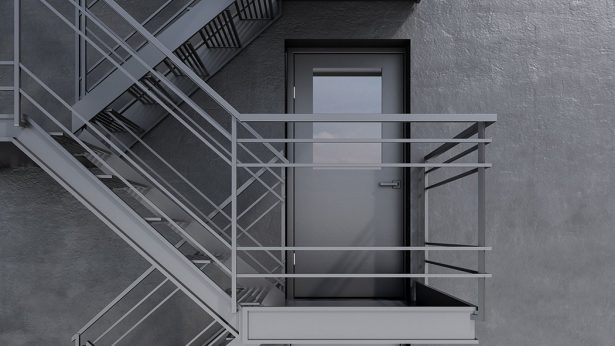TABLE OF CONTENTS
Fire doors are specially designed and purpose-built doors that have been rigorously tested to ensure they can withstand fires for as long as possible. By delaying the spread of fire, fire safety doors give people time to escape safely and are an essential part of any fire protection strategy.
Fire doors are made up of different components. In fact, a fire safety door refers to more than just the door itself. It includes the complete door assembly: the doorset fit with a door frame, leaf, hardware, seals, and integral panels. All these components must meet the necessary standards.
All fire safety doors must comply with the appropriate regulations. These are the Regulatory Reform (Fire Safety) Order: 2005 and Approved Document B of the Building Regulations.
However, there is a bit of flexibility when it comes to the material used to make the fire door and the fire rating of the fire door.

Different Types of Fire Doors: Materials
Fire-rated doors are made using a combination of different fire-resistant materials. These include:
Wood Fire Doors
Wooden materials can be used to make fire safety doors. Typically, a wood fire door will have a solid core made from materials such as timber, particleboard, flaxboard, timber, or magboard. A timber framing with a laminated outer, MDF and veneer, or plywood can then be added to this core.
Timber fire safety doors are very common and effective. In a 2018 government investigation into fire safety doors following the Grenfell Tower fire in 2017, it was found that wood fire safety doors outperformed composite materials such as glass-reinforced plastic.
Steel Fire Doors
Steel fire doors are typically made from low-carbon steel or stainless steel. Like wood fire doors, steel fire doors are highly durable. But steel fire safety doors can also provide extended fire protection, offering up to four hours on average, compared to 30 to 60 minutes for wooden or glass fire safety doors.
Steel fire safety doors are also strong and robust, offering added security. They are also easy to clean to a high standard, making them a good choice for hospitals or commercial kitchens where hygiene is an important consideration.
Another advantage of steel fire doors is that they can be custom-made to fit a space. Plus, steel doors are more corrosion-resistant than timber fire doors.
Glass Fire Doors
Glass fire doors can refer to one of two things.
First, you have glazed fire doors. These are usually made of timber or another material but feature a glazed vision panel for looking through, making them more functional. You find these kinds of doors in hospitals, for example.
It’s vital that any glazing in a fire door performs to the same fire safety standards as the rest of the door. Fire-rated glass is incredibly durable and rigorously tested to ensure it can withstand extreme temperatures of up to 900 degrees Celsius.
You can also get fire doors that are entirely made from pyropanel glass. These are less common but still, comply with fire safety regulations as long as they use fire-rated glass that has been tested to ensure it can act as a heat barrier.
Different Types of Fire Doors: Fire Ratings
The FD rating stands for fire door rating and refers to the amount of time the door can withstand fire.
For example, a rating of FD30 means it can provide 30 minutes of protection. FD60 means it offers 60 minutes of protection.
FD30 and FD60 are the most common fire safety ratings. However, you’ll also find FD20, FD90, and FD120 fire doors. These ratings are given following a comprehensive fire risk assessment and stress testing according to the guidelines laid out in BS 476-22:1987.
Approved Document B of 2010’s Buildings Regulations makes recommendations on the best FD rating for a fire door depending on its position in the building.
For example, a fire door in a compartment wall that separates two buildings should have a door with an FD60 rating. Fire doors that provide access to an escape route should have an FD30 rating.
Deciding on the Best Fire Door for You
As you can see, there’s a lot of variety when it comes to fire doors. This sometimes makes deciding on the type of fire door to install tricky – get it wrong, and you could be risking the lives of people within the building, as well as prosecution.
Therefore, we’d recommend always working with a professional with advanced knowledge of fire doors.
If you’re in London or any surrounding counties and need fire door installation, repair, or maintenance for your residential or commercial property, why not contact us today? We’ll give you honest advice, to ensure you get the exact fire door service you require.
Call us today on 01375 803000 or email us via our contact form.
Frequently Asked Questions About Types of Fire Doors
How do you identify a fire door?
To identify a fire door, check to see if it has a legitimate certification label, is indicated by the appropriate signs, and has gaps of less than 4 mm around the top and sides and less than 10 mm at the bottom. A fire door should also have intumescent strips or seals, three hinges, and should self-close from a halfway-open position without sticking.
What’s the difference between FD20 and FD30 fire doors?
FD20 fire safety doors can withstand fire for 20 minutes while FD30 fire doors can withstand fire for 30 minutes. FD20 and FD30 refer to the fire safety rating. You can also get FD60, FD90, and FD120 fire doors. The right fire safety rating for your fire door depends on where it is in the building.
What are the legal requirements for a fire door?
The legal requirements for a fire door are set out in the Regulatory Reform (Fire Safety) Order: 2005, Approved Document B of the Building Regulations, and the Fire Safety Act 2021. The legal stipulations require that fire doors comply with certain standards and have certain features, including intumescent strips, three hinges, and gaps of less than 4mm between the door and the frame.
How are fire doors different from normal doors?
Fire doors are different from normal doors because they are made from fire-resistant materials and have been rigorously tested to ensure they can withstand extreme heat. They also feature intumescent strips or seals that help seal the gap in the event of a fire. There are also regulations governing the gap between a fire safety door and the door frame.



